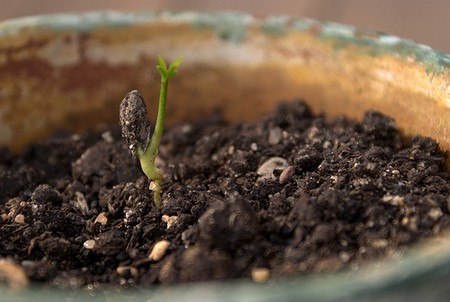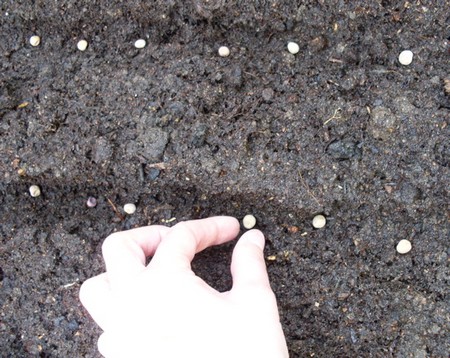Sowing indoors frees you from the vagaries of the weather and gives you much more control over seed germination. A greenhouse is the ideal place to start off vegetable seeds. It needs to be insulated and heated to prevent the temperature falling below freezing, or preferably keep it at about 3-5°C. A coldframe is a cheaper alternative to a greenhouse for hardy vegetables that do not need high temperatures to germinate.
Tender vegetables are best started off on a warm windowsill where you can maintain a steady temperature of about 20°C. Ideally, it should get plenty of sunlight but preferably not full sun, which could easily scorch young seedlings. As the sunlight comes from one direction, the seedlings will bend towards it, so turn pots daily to keep the stems growing straight. Remember that if you draw the curtains at night, the windowsill temperature will drop considerably.
A heated propagator
A heated propagator consists of a plastic seed tray with a heating element built into it. This provides gentle bottom heat, which is usually capable of raising the temperature of the compost up to ten degrees above the room temperature. This is useful for a cool room without central heating, a windowsill that gets cold at night when the curtains are drawn, or in a greenhouse. A transparent plastic top keeps the atmosphere moist; the best have adjustable ventilators to increase or decrease the humidity.
The main drawback of a simple propagator is that you need to remember to turn it off on warm, sunny days.
A propagator with a built-in thermostat will not get too hot, and with some propagators, the temperature can be adjusted to suit different types of seed.
Even the most powerful propagators will not be able to maintain 20°C if the room temperature drops much below 5°C, so background heating is essential in a greenhouse. It is worth checking the temperature in the greenhouse with a maximum-minimum thermometer.
Pots, trays or modules?
7-cm plastic plant pots are ideal for sowing most vegetable seed. Round pots are fine, but square ones can be fitted more neatly into trays if space is tight.
Modular trays are divided into square compartments and drop inside a standard seed tray. Those with 24 compartments are ideal for most vegetables, those with 40 will be more efficient for vegetables transplanted when quite small, such as lettuces.
Sowing
Fill the pot with seed compost or multipurpose compost up to the level of the rim. Press the surface gently to firm it, so that it is 2cm below the rim.
Water gently, with a fine rose attached to the watering can, or stand the pot in a tray of water, to moisten the compost. Allow excess water to drain.
Sow small seeds on to the compost surface. Press larger seeds into the compost. Scatter loose compost over the seeds, leaving roughly 0.5cm below the pot rim for watering.
With expensive Fl hybrid seeds, sow one or two seeds per pot or module. If both germinate, you can either pull out the weakest seedling and throw it away or prick it out into another pot. With cheaper seed, sow a small pinch and thin out later. Always label pots and trays with the variety name and date sown.
Pricking out
When a seed germinates, the first pair of leaves are actually part of the seed. The next pair to form are the first ‘true’ leaves and are more characteristic of the plant. Large seeds produce very large seed leaves and can be handled and pricked out as soon as they have fully opened. With smaller seeds, wait until at least one pair of true leaves has opened.
Prepare new pots full of firmed, moistened multipurpose compost for the seedlings. Use a dibber or something thin and pointed (a plastic plant label works well) to ease individual seedlings gently out of the compost with as much root intact as possible. Hold them carefully by the tip of a leaf, never the stem. Make a hole in the compost in a new pot and drop the root in. The seedling should end up at the same depth as it was in the original pot. Push the dibber into the compost beside the hole to firm the seedling in. Return the seedlings to a warm spot to recover.
Potting on
Any vegetable that is likely to be in its pot for more than six weeks, or which grows very fast, is best transferred into a larger pot, say, 10cm. If the larger pot is also deeper, put a layer of compost in the bottom. Remove the plant with the ball of compost intact from the smaller pot. Do not pull the stem – put your hand over the top of the pot, with the plant stem between your two middle fingers. Tap firmly on the bottom of the pot. Drop the plant plus compost into the larger pot and fill around it with fresh compost.
Categories
Advertisements
Recent Articles
 How to Understand Bed Sizes – A Small Guide
How to Understand Bed Sizes – A Small Guide How to Select Some Must Have Kitchen Accessories
How to Select Some Must Have Kitchen Accessories Best Way to Change a Car Tire
Best Way to Change a Car Tire Best Way to Write an Affirmation
Best Way to Write an Affirmation Best Way to Take Charge of Your Financial Life
Best Way to Take Charge of Your Financial Life Best Way to Survive a Party When You Don’t Know Anyone
Best Way to Survive a Party When You Don’t Know Anyone Best Way to Stop Self Sabotaging Yourself
Best Way to Stop Self Sabotaging Yourself Best Way to Start Journal Writing
Best Way to Start Journal Writing Best Way to Speak with a Powerful Voice
Best Way to Speak with a Powerful Voice Best Way to Simplify Your Life
Best Way to Simplify Your Life Best Way to Respond to a Put-Down
Best Way to Respond to a Put-Down Best Way to Reduce Acne Breakouts
Best Way to Reduce Acne Breakouts Best Way to Recover from Dining Disasters
Best Way to Recover from Dining Disasters Best Way to Quit Your Job Gracefully
Best Way to Quit Your Job Gracefully Best Way to Make Your Own Website
Best Way to Make Your Own Website



Leave a Reply